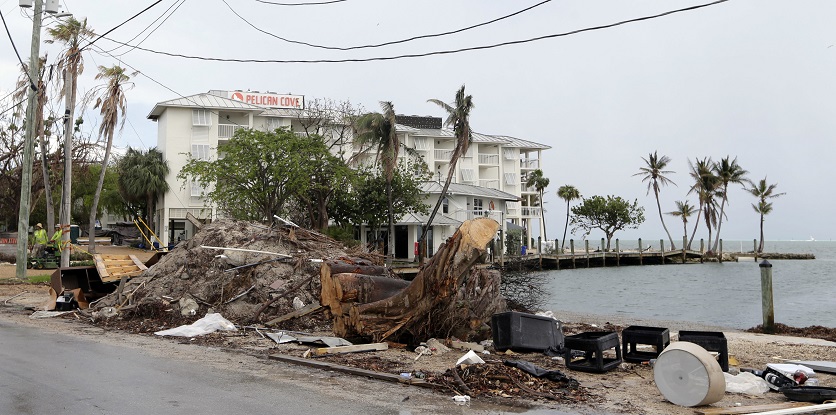"OutFront Ideas with Kimberly and Mark" is a complimentary webinarseries and interactive forum that explores critical workers'compensation-related issues.
|The first installment for 2018 covered workers' compensationissues to watch.
|What follows are 10 of the issues we discussed when looking atworkers' compensation trends that insurance and benefitsprofessionals should follow in the coming year. Clickhere to listen to the entire webinar.
|No. 10: The healthcare industry continues toevolve.
The pace of change within healthcare is rapid, and the evolutionis vast, encompassing everything from pharma to practice totechnological disruptors.
|Consolidation and mergers and acquisitions in the healthcarespace will continue in 2018. As CVS looks to broaden with theacquisition of Aetna, do not be surprised if Amazon, Walmart andother large employers expand their reach into health as well.
|Related: Is it possible to fix the healthcaresystem?
|Health systems have been merging for years. In some of themergers, we are now beginning to see hospital and facility exitsresulting in local disruption for patients, providers, insurers,and the benefit and risk programs of those impacted.
|For many years, health plans have been in the business ofdelivering patient care. Probably the best example is KaiserPermanente, operating as both a health plan and healthcareprovider. Similar to UHG's announcement of their DaVitaacquisition, we will likely see more payer/practice intermix in2018. Drug companies are purchasing other drug companies and, giventheir R&D cycles, generic and biosimilar opportunities, we donot anticipate this to decrease.
|Related: Workers' Comp 101
|What's more, under Dr. Scott Gottlieb's oversight at the FDA,expect to see approval and safety pathways accelerated in 2018,which will enable speed to market for new generic drugs, digitalhealth software, and medical devices.
|A few additional hot healthcare-related topics will include:
- Scope of practice advancements for physicianassistants and nurse practitioners given theirunderutilization.
- Competition for convenient, quicker,more-accessible options for care with growing emphasis on communitycare, home care, retail clinic care, and telemedicine.
- For most medical providers, revenues are flatwhile expenses continue to rise, prompting significant focus onefficiency. Offices and systems need to improve speed of deliveryand agility at all levels.
- Value-based care models and value-basedreimbursements. Examples in workers' compensation includephysician/health system pay for outcomes and bundled paymentsarrangements. Health plans look at population health outcomes andcontinue to advance accountable care organization (ACO)models.
- Pharma continues to aggressively address theneed to create value for outcomes related to drug pricing. Thedebate there continues. How much is a drug worth if it literallysaves the life of a patient?

Four states in particular are expected to update workers'compensation laws this year. (Photo: iStock)
|No. 9: Legislative reform on the horizon
Thirty-four of the 50 state governors are currently Republicans.This, combined with the fact that insurance rates are down in mostof the U.S., means we have not seen a significant push for workers'compensation reforms the last few years.
|Related: Moving the needle: WSIA's legislative effortscontinue
|However, there are still some states where significant activityis expected in 2018.
- Florida will again attempt to fix theplaintiff attorney fee caps that were found unconstitutional by thestate supreme court two years ago.
- Pennsylvania had the part of its workers'compensation statutes dealing with the evaluation of impairmentfound unconstitutional in 2017. Efforts are underway to correctthis legislatively.
- Expect the workers' compensation reformbattles between Illinois Governor Rauner and theDemocrat-controlled legislature to continue. This is an electionyear for the Illinois governor.
- In California, it is Governor Brown's lastyear. Expect yet another push by the legislature to undermine priorworkers' compensation reforms. Universal healthcare will likely bean issue in the 2018 governor's race and the outcome of thiselection could have a significant impact on workers' compensationin 2019.

We have seen a positive trend in states adopting treatmentguidelines and drug formularies, which can help injured workers getproper, timely care and help to reduce unnecessary treatment.(Photo: iStock)
|No. 8: Treatment guidelines and drugformularies
In 2018, California, New York and Arkansas will all beimplementing new treatment guidelines or drug formularies. Montanais also implementing a drug formulary but the timeline for this isnot set yet.
|Georgia, Pennsylvania, North Carolina and Louisiana allconsidered either treatment guidelines or drug formularies in 2017and we expect them to revisit this again in 2018.
|
It's important to monitor the court decisions in your stateas it is to monitor legislative activity. (Photo: iStock)
|No. 7: Judicial watch
Every year around the country, judges modify the practice ofworkers' compensation in their state based on their interpretationof the statutes. These interpretations can significantly expand orrestrict workers' compensation benefits in the state.
|Along those lines, challenging the constitutionality of workers'compensation statutes is a trend that is expected to continue in2018. Last year, Pennsylvania joined the list of states to have aportion of their workers' compensation statutes foundunconstitutional by the state supreme court. There is a case onappeal in Kansas right now challenging the constitutionality of aportion of their statute as well. It is worth noting that the basisfor these constitutional challenges exists in many otherstates.
|Related: What happens when a workers' comp carrier goesbroke
|Finally, last year, a judge in Alabama declared the state'sentire workers' compensation statutes unconstitutional. This wasappealed, and the case settled on appeal, so that decisionultimately was rendered moot. However, the issues raised in thatcourt case regarding benefit adequacy are something we could seeagain anywhere.
|
Evolving issues related to workplace violence and harassmentare something to watch in 2018. (Photo: iStock)
|No. 6: Raising workplace violence awareness
Whether they are engaging consultants to assist with planning orconducting revised employee training, risk managers and HumanResources are working together to ensure they have a solid programin place. There is an uptick in patient attacks on healthcareworkers. This is happening all too often, ranging from emergencyroom to mental health facilities and nursing home caresettings.
|Related: How does insurance cover mass shootingevents
|Given that 2017 marks an unprecedented awareness of sexual harassment in the workplace, we areadding workplace harassment as an issue to watch. Employers smalland large are looking at their sexual harassment policies,training, and complaint investigation processes.
||
Workers' compensation is a state-based system, and thevariation between the states is something that has been attractingconsistent attention. (Photo: iStock)
|No. 5: State-based system variations
Two people performing the same job for the same company indifferent states can receive significantly different workers'compensation benefits. The very definition of an employee varies bystate. From the administrative side, a lack of consistency withregard to state forms, data templates and even the definition ofdisability is very challenging to payers.
|Related: Here are the top 10 states people are movinginto
|The U.S. Department of Labor started looking into these issuesin late 2016, but those efforts stopped after the election ofPresident Trump. However, those issues are still very real and needto be addressed. Now is probably the best time to establishstandards between state workers' compensation systems —now when the federal government is not pushing for it. If no actionis taken, it is likely that the federal government will push forthis in the future.
|Related: Here are the top 10 states people are movingfrom
||
When it comes to pain management, one size does not fit all.(Photo: iStock)
|No. 4: Fresh approaches to pain management
Everyone is keenly aware of the opioid crisis and the importance of taperingnarcotics, narcotics avoidance, formularies, and deaths relatedto opioids. 2018 provides the opportunity to advance ourunderstanding of these issues and willingness to change treatmentprotocols for patients in pre-pain, acute pain, and chronic painstates.
|Related: The opioid epidemic in workers'comp
|Personalization of care and working in partnership with thepatient, their family or support system, and providers tocollectively create a treatment pathway for the patient isimportant to ensure success.
|
Multiple major hurricanes and widespreadwildfires throttled the U.S. during 2017. Such events canhave a major impact on local healthcare systems. (Photo: APImages)
|No. 3: Getting ready for the next natural disaster
Last year (2017) saw unprecedented natural disasters in the United States.
|Natural disasters can have a big impact on workers' compensationand healthcare systems, including the risks faced by firstresponders, the disruption to your workforce, challenges to thebenefit delivery system, and supply chain disruption.
|Related: 10 U.S. cities with the highest & lowestnatural-disaster risk level
||
Every company has cyber risks. (Photo:Shutterstock)
|No 2: Facing down cyber threats
Cyber preparedness and recovery is now a dailypriority for the CIO.
|Cyber risk reaches beyond hacking and selling personalidentifiable information on the deep dark web. It can be a life anddeath concern.
|Health systems locally and worldwide were hit withransomware in 2017 shutting down hospital and practice computersystems while demanding money in exchange for digital keys tounlock the systems. Patient data hacks have resulted in medicaldevice malfunctions and treatment delays. A recent cyber attack onMerck impacted its ability to produce medicines. Workers'compensation payers, service providers, and stakeholders areequally at risk. Past history shows companies without a solid cyberinsurance program put their business at risk. Companies andcustomers will place even greater emphasis on cyber risks in2018.
|Related: Protecting against cyber risks
||
Multiple brokers have indicated that the workers'compensation rate outlook for 2018 is relatively flat. (Photo:iStock)
|No. 1: Anticipating rate adjustments
For the last few years, workers' compensation rates around thecountry have been flat to down in most states. This is in spite ofthe fact that NCCI data shows that, over the last 20 years, theaverage medical and indemnity costs per lost time claim haveincreased at rates greater than inflation.
|In 2017, two of the top 10 writers of workers' compensationposted multi-million dollar reserve increases to cover theirdeveloping losses. This attracted the attention of rating agenciessuch as A.M. Best who, in a September report, raised concern aboutthe threat of inflation on workers' compensation tail costs and theimpact this could have on industry reserves.
|Multiple brokers have indicated that the workers' compensationrate outlook for 2018 is relatively flat. But with workers'compensation being such a long-tail business, premiums collectedtoday must cover losses 30 years into the future. As lossescontinue to climb, it is inevitable that insurance rates will needto increase in the future to offset those losses.
|Mark Walls is vice president of Communications& Strategic Analysis at SafetyNational. He can be reached by sending emailto [email protected].
|Kimberly George is the senior vicepresident of Corporate Development, M&A and Healthcareat Sedgwick Claims Management Services, Inc. Shecan be reached by sending email to [email protected].
|See also:
|Top 10 Workers' Comp carriers, as ranked byNAIC
||Want to continue reading?
Become a Free PropertyCasualty360 Digital Reader
Your access to unlimited PropertyCasualty360 content isn’t changing.
Once you are an ALM digital member, you’ll receive:
- All PropertyCasualty360.com news coverage, best practices, and in-depth analysis.
- Educational webcasts, resources from industry leaders, and informative newsletters.
- Other award-winning websites including BenefitsPRO.com and ThinkAdvisor.com.
Already have an account? Sign In
© 2024 ALM Global, LLC, All Rights Reserved. Request academic re-use from www.copyright.com. All other uses, submit a request to [email protected]. For more information visit Asset & Logo Licensing.








